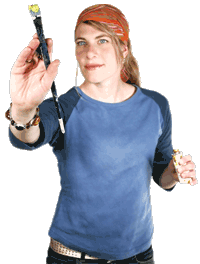At MusicalExpert, we're committed to delivering accurate, trustworthy information. Our expert-authored content is rigorously fact-checked and sourced from credible authorities. Discover how we uphold the highest standards in providing you with reliable knowledge.
What are Woodcuts?
As an example of relief printing, woodcuts represent an artistic approach to printmaking that has been around for centuries. Beginning with a simple block of wood, the woodcut is a means of creating visual works by employing techniques such as stamping, rubbing, and use of a printing press. Referred to as xylography, the creation of woodcuts is considered to be a time honored art form. Here is some background on woodcuts, and how they work.
Preparing a block of wood for use in a series of woodcuts involves chiseling or gouging away the portions of the flat side of the block that are not required as part of the design. It is important to make sure that the gouges are made in such a manner that they go along with the natural grain of the wood, rather than running against the grain. This helps to ensure that when the completed template is inked and brought into contact with the printing surface, there is less of a chance of smearing. Careful and precise creation of the design will result in what is essentially a solid image that can be transferred onto paper, canvas or any surface that the artist wishes to use.

Ink is usually administered to the wood block by rolling over the surface of the template with a device that is referred to as a brayer. The brayer is essentially a roller that helps to distribute the ink evenly over the gouged surface of the block, thus ensuring an even coat when the ink is applied to the print surface. When more than one color is desired as part of the overall design, the surface of the wood block can be cleaned, and a different color of ink applied to the print. The use of two or more colors in woodcuts has always been popular, with the practice of multiple colors gaining more attention in recent years.
Stamping a single wood block to the print surface is often the popular means of creating woodcuts. In addition, a process known as rubbing may create interesting designs for woodcuts. This involves placing the block on a flat surface, placing the paper over the block, and then rubbing the area to reveal a design. Last, multiple blocks may be assembled onto a printing press and used to mass create woodcuts that are ideal for use in books as well as the mass production of woodcuts that serve as wall prints and other forms of decoration.
AS FEATURED ON:
AS FEATURED ON:










Discussion Comments
I had to take an art history class, and I ended up loving it. I developed an appreciation for art. I remember being particularly impressed with the renaissance woodcuts we viewed on the projector.
These prints were so detailed that it must have taken months to complete the carvings. Tiny little areas the size of needles were carved out to show shading. It looked as if the artist had taken a pencil and drawn tons of little lines.
Parts of the wood must have been lightly cut or sanded down, because there were gray areas leading up to the black parts. So, some ink would have had to touch them, but not enough to turn them solid black.
When I studied printmaking, woodcuts were one of the things we tackled in class. We used small blocks of wood that measured 5"x5,” and we were told to carve a vegetable or fruit image.
Before becoming eligible to take this class, everyone had to complete drawing courses. So, we already knew about shading and detail. We all incorporated this into our carvings, using different sized lines to represent more or less shadow.
We used the back of a spoon to rub our paper onto the wood. Putting this wood through the tight press would have broken it, and we would not be able to make more prints from it.
@lighth0se33 - The cool thing about woodcuts is their versatility. You can have a lot of deep lines for a detailed image like yours, or you can have a few simple ones to show the basic idea. This makes woodcuts great for children’s art classes.
I teach a class of fifth-graders, and I show them how to do a simple woodcut. We start with the basic outline of a cat, which we draw onto our blocks. Some kids draw better than others, but just about everyone can draw a decent cartoonish cat.
I show them how to carefully gouge the wood away from the blank areas. This can take awhile with simple designs, because most of the area will remain white.
The students then ink the blocks and press the paper down on them. They absolutely love peeling the paper away and seeing what they created.
The only award I have ever won was for a woodcut I did in college. We were told to do a self portrait, and mine was so solemn that it beat out the other normal looking ones at the museum’s art contest.
I first sketched out a design on paper. Then, I drew it with a pencil on the block of wood. The tricky part was remembering that the pieces to cut away were the areas of negative space.
I drew myself with my eyes closed as if deep in thought. My hair was long and straight, and this made the portrait more stark. I was not smiling. Because I carved so many areas away, I had a lot of dark lines in my face to show its shape and my somewhat pained expression.
Post your comments